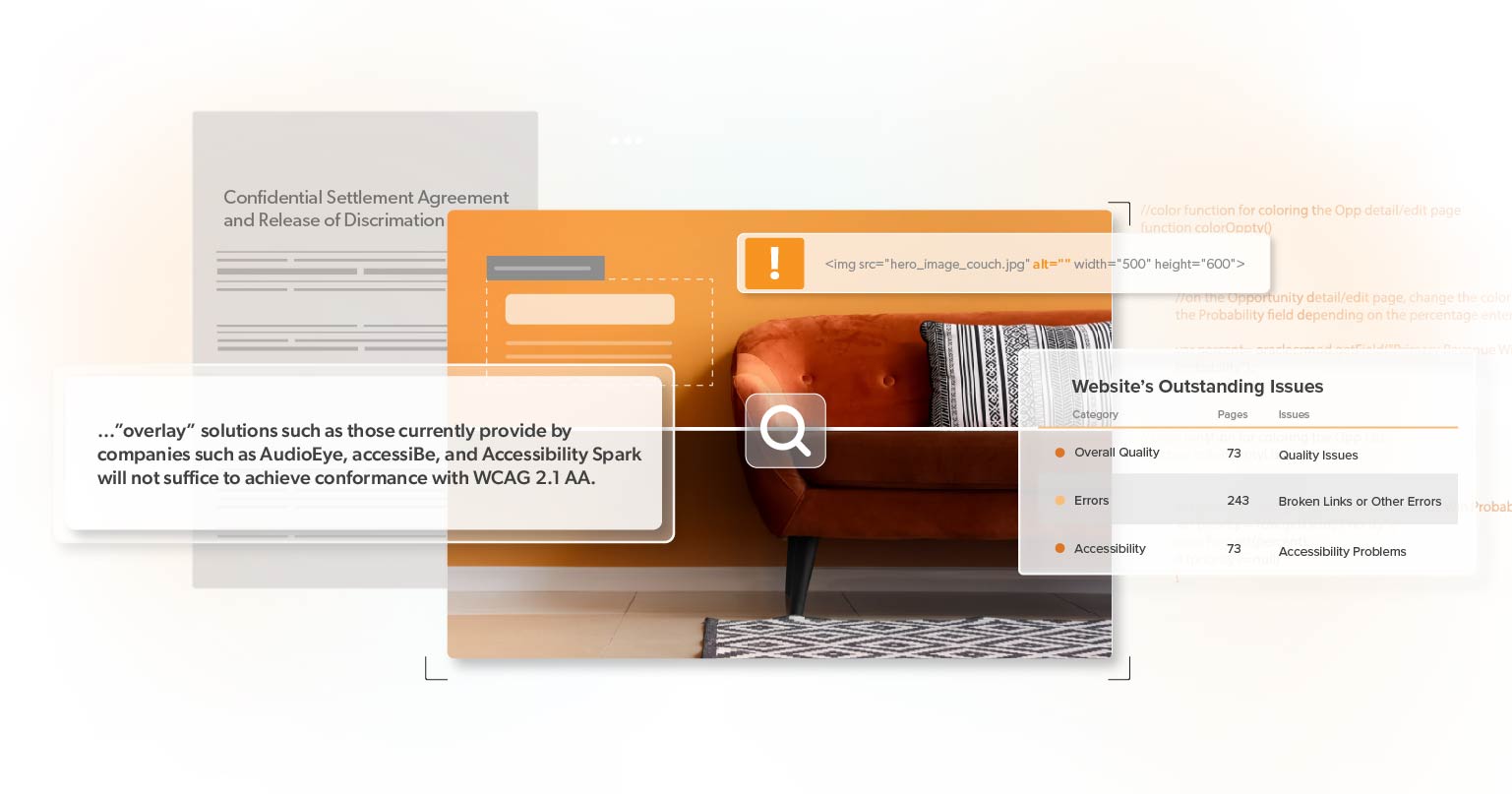As we reach the midpoint of 2024, it’s crucial for business owners, project managers, and web development teams to stay informed about trends and challenges related to ADA lawsuits, especially concerning web accessibility. In recent years, the landscape of digital accessibility has evolved significantly, impacting businesses of all sizes across various industries. This article aims to provide a comprehensive mid-year report on ADA lawsuits, upcoming trends, and proactive measures to protect your online business.
Trends in 2024 for ADA Lawsuits
As we move through 2024, the landscape of Americans with Disabilities Act (ADA) lawsuits is undergoing significant changes. Several emerging trends reflect shifts in legal practices, targets of litigation, and evolving standards in web accessibility. Here’s a comprehensive look at what you can expect in the upcoming months.
Decrease in Overall ADA Lawsuit Numbers
For the first time in years, there has been a slight decrease in the number of ADA lawsuits filed. In fact, we are anticipating to have 600 less federal court case than in 2023. This reduction is primarily due to increased judicial scrutiny. Judges now require plaintiffs and their legal teams to present more detailed and specific claims. Vague or generic allegations no longer suffice to move forward in court. This heightened scrutiny is filtering out cases deemed frivolous or opportunistic, leading to a decrease in the overall number of filings.
Impact of Recent Defense Victories
Recent defense victories in federal ADA claims have also contributed to this decline. These victories have set precedents that make it more challenging for plaintiffs to succeed with less substantiated claims. As a result, some law firms are shifting their focus to state courts, where they might perceive a higher chance of success. This shift is impacting the overall landscape of ADA lawsuits, with fewer cases reaching the federal level.
Small Companies Are in the Crosshairs
Interestingly, there has been a significant shift in the targets of ADA lawsuits. Over 66% of the lawsuits filed through June 2024 have been against companies with revenues under $25 million. In contrast, 34% have been against larger companies. This shift is a natural progression after years of lawsuits targeting major corporations. Many of the largest companies have already faced lawsuits and implemented comprehensive accessibility programs, leaving smaller businesses as the new focus for plaintiffs.
The Rise of eCommerce and ADA Violations
The rise in eCommerce, driven by changing consumer spending habits, has exposed more small and medium-sized businesses to potential ADA violations. As these businesses expand their online presence, they become more susceptible to lawsuits if their websites are not fully accessible. Smaller businesses may lack the resources or knowledge to ensure full compliance with ADA requirements, making them vulnerable targets for litigation.
Overlays Could Make You a Target Now More Than Ever
Despite significant investments in accessibility widgets, these tools often fail to reduce legal risks effectively. In fact, in 2024, plaintiffs have already filed 503 lawsuits against websites with active widgets, compared to 449 in 2023. This is a 20% increase in lawsuits against websites using widgets and screen overlays. These tools are marketed as quick fixes for accessibility issues but frequently fall short of their promises.
Common Problems with Widgets
It has been proven that accessibility widgets can create additional barriers for users with disabilities. Common problems include incompatibility with screen readers, failure to address all accessibility concerns, and even introducing new issues. These limitations highlight that relying solely on widgets is not an adequate solution for legal protection or genuine accessibility improvements. Businesses must seek comprehensive solutions to ensure their websites are fully accessible.
Evolving Legal Standards
The legal landscape surrounding web accessibility is continuously evolving. On April 8, the U.S. Attorney General signed a new rule under ADA Title II, setting clear web accessibility standards for state and local governments. This means their services, programs, and activities must now be accessible to people with disabilities. Depending on the size of their websites, these entities have two to three years to implement these accessibility standards.
Potential Changes to ADA Title III
While the current update focuses on public sector entities under ADA Title II, it could serve as a model for changes to Title III, which covers public accommodations and commercial facilities. This potential shift might lead to stricter and more uniform accessibility standards in the private sector, affecting businesses and nonprofits that interact with the public.
Increased DOJ Enforcement
The Department of Justice (DOJ) is expected to increase enforcement efforts, ensuring that businesses comply with these evolving standards. This means that businesses must stay informed about these changes and proactively work towards compliance to avoid potential lawsuits and penalties. Staying ahead of these legal standards will be crucial for businesses to minimize legal risks and enhance accessibility for all users.
The Importance of Staying Informed
Staying informed about the latest trends and legal changes in ADA compliance is crucial for businesses of all sizes. This not only helps in avoiding potential lawsuits but also ensures that businesses are accessible to all customers, enhancing their reputation and customer satisfaction. Companies should consider consulting with legal experts and accessibility professionals to stay ahead of the curve and implement best practices in web accessibility.
How to Protect Your Online Business
Navigating the complexities of ADA compliance can seem daunting, especially for those with limited knowledge of web accessibility standards. However, there are practical steps you can take to mitigate the risk of lawsuits and foster a more inclusive digital environment:
1. Conduct an Accessibility Audit
Start by conducting a comprehensive accessibility audit of your website. This involves assessing your site’s adherence to WCAG standards and identifying areas that may pose accessibility barriers. Consider engaging accessibility experts or using automated tools to assist in this process.
2. Implement Accessibility Improvements
Based on the findings of your audit, prioritize and implement necessary accessibility improvements. This may include optimizing navigation for keyboard users, providing alternative text for images, ensuring color contrast ratios comply with standards, and making multimedia content accessible.
3. Train Your Team
Educate your web development team, content creators, and digital marketers about web accessibility best practices. Training sessions can help increase awareness of accessibility guidelines and empower your team to proactively address accessibility issues in their respective roles.
4. Monitor and Maintain Accessibility
Accessibility is an ongoing commitment. Regularly monitor your website for accessibility compliance and address any new issues that arise. Incorporate accessibility checks into your regular maintenance routines to ensure ongoing compliance.
5. Seek Legal Guidance if Needed
If you receive a demand letter or face a lawsuit related to ADA non-compliance, seek legal guidance promptly. ADA litigation can be complex, and legal professionals specializing in accessibility law can provide valuable counsel and representation.
Conclusion
As we move forward in 2024, the landscape of web accessibility and ADA compliance continues to evolve. By prioritizing accessibility in your digital strategy and staying informed about legal requirements, you not only mitigate legal risks but also enhance the overall user experience for all visitors to your website. Remember, accessibility is not just a legal obligation but also a moral imperative to ensure inclusivity and equal access to information in the digital age.
For more information on ADA compliance and web accessibility best practices, schedule a complimentary ADA strategy briefing with 216digital. Together, we can create a more inclusive online environment that benefits businesses and individuals alike.









